Battle of Guyandotte
Introduction
Text-to-speech Audio
On November 10, 1861, a Confederate cavalry force of more than 700 attacked a Union recruitment camp for the Ninth (West) Virginia Infantry regiment along the port town of Guyandotte in Cabell County. Led by Col. John Clarkson, the Confederates quickly overcame the brief resistance of the federal recruits, who numbered some 150 men. Allegedly many pro-Confederate residents in town participated in the fighting, even firing on Union troops. Casualties were minimal, but the Confederates captured around 100 Union soldiers before leaving. On November 11, the Fifth (West) Virginia Infantry, arriving too late to intervene in the battle, burned the town in retaliation for its purported role in aiding the Confederates. A large portion of Guyandotte was destroyed, including the Buffington Mill. Today the Battle and Burning of Guyandotte are commemorated with several markers and an annual series of reenactments.
Images
Marker in backyard of Madie Carroll House
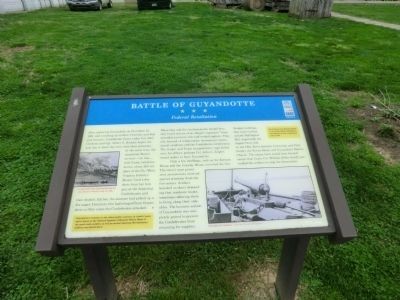

Civil War Days event depicting the Battle of Guyandotte
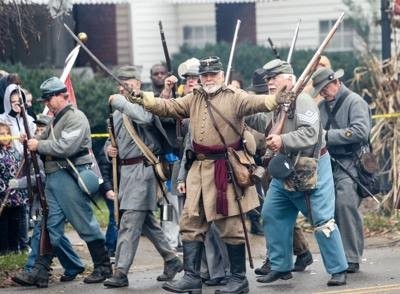
This marker commemorating the Battle of Guyandotte was installed on Main Street by West Virginia Archives & History in 2016. Image obtained from the Historical Marker Database.
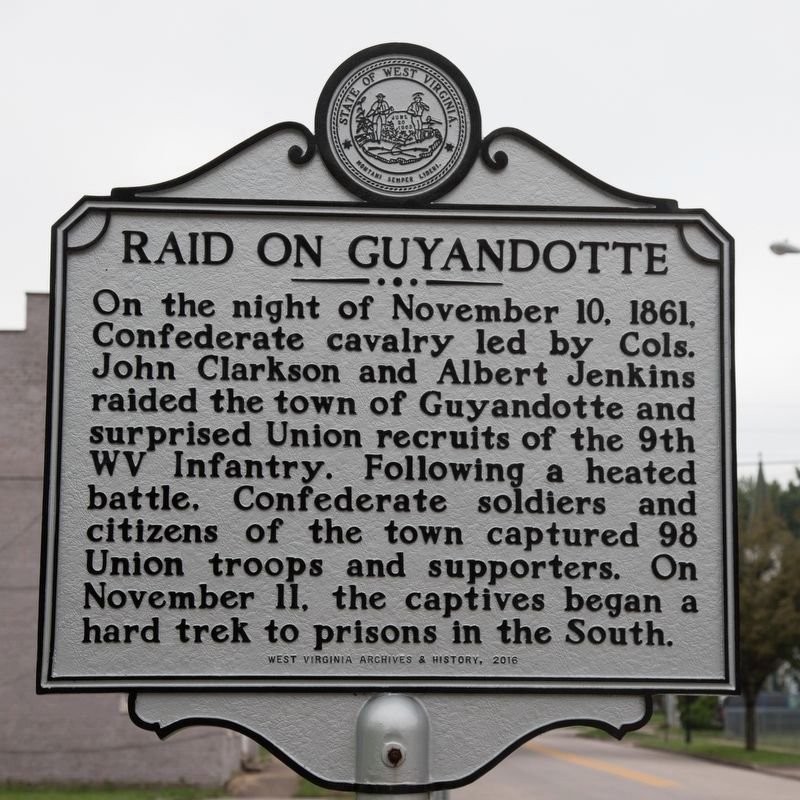
Two wayside markers providing information on the battle are located near the Madie Carroll House. Image obtained from the Historical Marker Database.
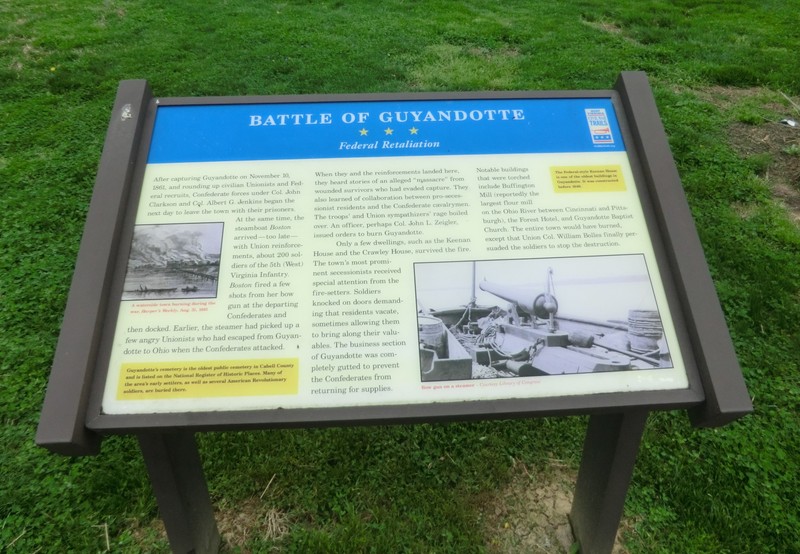
WV Historical Marker
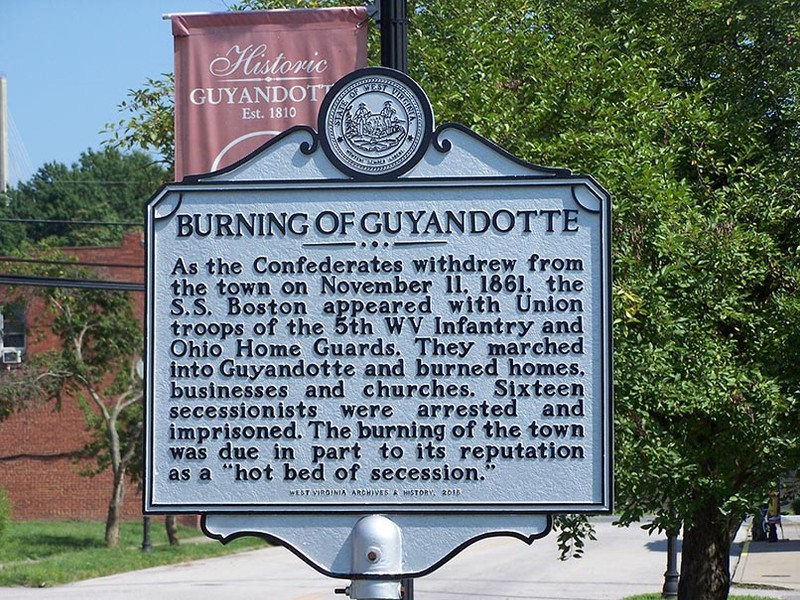
Backstory and Context
Text-to-speech Audio
At the beginning of the Civil War in 1861 Cabell and Wayne Counties were deeply divided, with residents flocking to join opposing regiments. The small town of Guyandotte was purportedly the only town along the Ohio River to support secession from the Union. In April 1861 citizens of Guyandotte raised the state flag of Virginia, gave speeches, and began organizing into volunteer companies for the Confederate Army. This included a group known as the Border Rangers, led by Albert Gallatin Jenkins. Meanwhile just a few miles down the river a Union regiment, the Fifth (West) Virginia Volunteer Infantry Regiment was organized in the Unionist town of Ceredo. Once the Confederate recruits were deployed east to the Kanawha Valley, Guyandotte was left undefended and quickly came under the control of Union forces. In July the Second Kentucky Infantry briefly occupied the town and several locals were made to take an oath of allegiance to the Union.
In October 1861, Col. Kellian V. Whaley arrived in Guyandotte and established a recruiting base for a new Union regiment, the Ninth (West) Virginia Infantry. Around 150 men were recruited, but they received little training during their time in Guyandotte. In early November, Confederate Gen. John B. Floyd ordered a cavalry raid against Union positions in the direction of the Ohio River. A force of perhaps 700 men from the Fifth and Eighth Virginia Cavalry Regiments made their way towards Cabell County, led by Col. John Clarkson and Col. Albert Gallatin Jenkins, respectively.
On the evening of November 10, 1861, the Confederate force launched a surprise attack on Guyandotte and overwhelmed the outnumbered Union recruits. Whaley attempted to mount a defense, but his troops were untrained and the Confederates were too fast. A bridge on the Guyandotte River in the west was captured, while another group advanced into the eastern side of Guyandotte, encircling the Union troops. Several were shot trying to swim across the Guyandotte River. Whaley and a small number of troops continued to resist but were pushed back to the Forest Hotel and eventually forced to surrender. Approximately three Confederate troops were killed and ten wounded; ten Union soldiers were killed and around the same number wounded. 100 Union troops were captured, including Whaley, while perhaps less than fifty escaped. Allegedly many residents of Guyandotte participated in the raid, with some reports of them firing on Union troops from their homes.
The following morning, November 11, Col. John Zeigler and a detachment of Union troops from the Fifth (West) Virginia Volunteer Infantry from Ceredo arrived in Guyandotte via the Ohio River on the steamship Boston. They came just as the last Confederate raiders and their prisoners were leaving, too late to intervene in the battle. The troops of the Fifth were angered by the casualties, prisoners, and the rumors that secessionist residents participated in the raid. Some sources allege that Zeigler ordered the town to be torched; others suggest the action was spontaneous. At any rate, Union troops began setting fire to the town. Homes and businesses belonging to secessionists were the primary target, but property belonging to Unionists was reportedly burned as well. Much of Guyandotte was destroyed, including the Buffington Mill, Guyandotte Baptist Church, the business district, and many homes. The Madie Carroll House was one of the few structures to survive; Mary Carroll barricaded herself in the home, forcing the troops to move on.
As they left Guyandotte the troops arrested sixteen residents for their alleged roles in the raid and shipped them to Camp Chase Prison in Columbus, Ohio. Ohio played a significant role in the actions surrounding these conflicts. Aside from the Ohio militia which participated in the capture and burning of the town, the Fifth West Virginia Infantry was also heavily composed of Ohio men, with Lawrence County, OH, contributing over 400 men to the regiment, as well as 129 men to the Ninth West Virginia Infantry.(Dickinson, pg. 136; Taylor, pg. 291) The Second Kentucky Regiment was also composed mainly of Ohio men, despite its official credit to Kentucky.(Official Records of the Soldiers of Ohio, pg. 279)
Guyandotte... has always had the reputation of being the 'ornaryest' place on the Ohio River... It was a Vicksburg on a small scale. It was the first town on the Ohio river to display a secession flag, and has always been the worst secession nest in that whole country. It ought to have been burned two or three years ago. -Wheeling Daily Intelligencer, November 13, 1861.
Over the following days the Battle of Guyandotte was reported in many Northern papers, referred to exaggeratedly as a “massacre” despite few actual casualties. Many also expressed support for the Fifth (West) Virginia’s decision to destroy the town; the Wheeling Daily Intelligencer even commented that Guyandotte was “the worst secession nest in that whole country” and stated that it should have been burned years ago. The town was occupied by Union forces for much of the remainder of the war, and no more Confederate attacks were attempted on the community. Guyandotte rebuilt after the destruction and was eventually absorbed into the new city of Huntington. In the early 1990s the community launched an annual festival called Guyandotte Civil War Days. Occurring each November, the multi-day festival includes a reenactment of the battle and presentations on Civil War history.
Sources
“Ceredo Reinforced.” Wheeling Daily Intelligencer. November 18, 1861.
Cincinnati Daily Press. November 12, 1861.
Evening Star. November 12, 1861.
Foster, Jeff. “The One Civil War Battle in West Virginia That Nearly Destroyed An Entire Town.” Only In Your State. December 7, 2017. Accessed June 24, 2019. https://www.onlyinyourstate.com/west-virginia/battle-of-guyandotte-wv/.
Geiger, Joe Jr. “Battle of Guyandotte.” e-WV: The West Virginia Encyclopedia. February 13, 2012. Accessed June 24, 2019. https://www.wvencyclopedia.org/articles/96.
Geiger, Joe Jr. “The Tragic Fate of Guyandotte.” West Virginia History 54 (1995): 28-41. Accessed June 24, 2019. http://www.wvculture.org/history/journal_wvh/wvh54-2.html.
Morfe, Don. “Battle of Guyandotte: Federal Retaliation.” The Historical Marker Database. June 16, 2016. Accessed June 24, 2019. https://www.hmdb.org/Marker.asp?Marker=73715.
Morfe, Don. “Battle of Guyandotte: Massacre of the 9th Infantry.” The Historical Marker Database. June 16, 2016. Accessed June 24, 2019. https://www.hmdb.org/Marker.asp?Marker=73717.
New York Herald. November 12, 1861.
“Particulars of the Guyandotte Surprise – A Horrible St. Bartholomew’s Massacre.” Wheeling Daily Intelligencer. November 13, 1861.
Prats, J. J. “Raid on Guyandotte/Burning of Guyandotte.” The Historical Marker Database. November 6, 2018. Accessed June 24, 2019. https://www.hmdb.org/Marker.asp?Marker=125979.
“Reported Destruction of the Village of Guyandotte.” Wheeling Daily Intelligencer. November 12, 1861.
“The Guyandotte Raid.” Wheeling Daily Intelligencer. November 13, 1861.
Dickinson, Jack L.. Wayne County, West Virginia, in the Civil War. Higginson Book Co., 2003.
Official Roster of the Soldiers of Ohio in the War of the Rebellion, 1861-1866, Compiled under the direction of the Roster Commission, Vol. 12. The Laning Co., 1895.
Taylor, Charles B.. A Standard History of the Hanging Rock Iron Region of Ohio. Lewis Publishing Co., 1916.
"West Virginia's Sesquicentennial Highway Historical Markers." Accessed September 18, 2020. http://www.wvculture.org/history/markers/sesqui/burningofguyandotte.html.
